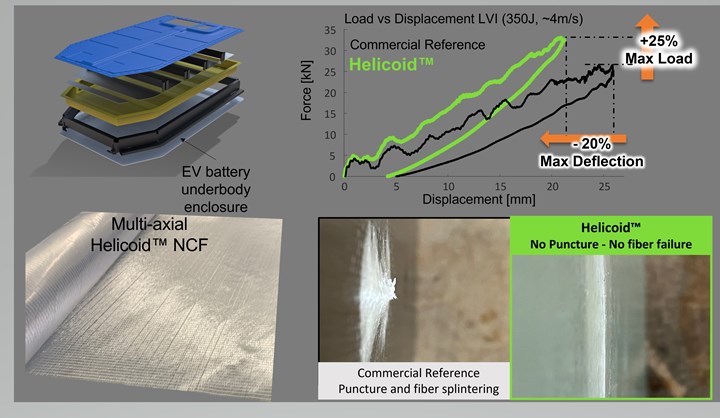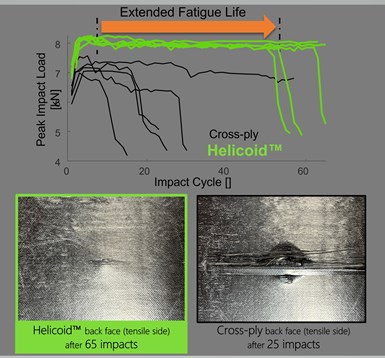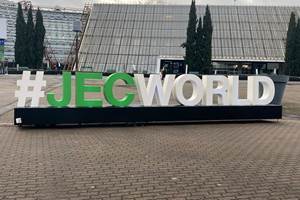Helicoid Industries releases three use cases of Helicoid technology
Use case applications with Helicoid technology implementation demonstrated mechanical performance improvements, such as impact resistance and strength.
Electric vehicle (EV) underbody enclosure use case and results. Photo Credit, all images: Helicoid Industries
Helicoid Industries Inc. (Indio, Calif., U.S.) successfully released three use cases highlighting its Helicoid technology at this year’s CAMX. The bio-inspired solution enables improved performance of advanced composites, leading to lighter structures, while achieving high cost efficiency and sustainability. According to the company, the deployment of Helicoid can be realized with no change in raw materials (fiber and resin), and no change in the manufacturing process (see “Creating stronger composites through nature-inspired, Helicoid designs”).
The first use case was a collaboration between Helicoid Industries Inc., TPI Composites Inc. (Scotsdale, Ariz., U.S.) and Saertex GmbH (Saerbeck, Germany) focusing on improving the mechanical performance of electric vehicle (EV) battery pack underbody protection plates made of E-glass Helicoid multiaxial noncrimp fabrics (NCFs) infused with a thermoset resin.
Key mechanical requirements of EV protective enclosures (more on this topic, see Part 1 and Part 2) are mainly tailored to resist road impact with the objective of guaranteeing the survivability and integrity of the battery module. Specifically, these requirements include resistance to perforation, reduction of fiber splintering (i.e., high structural integrity) and reduction of deflection under impact.
Prototyping and testing with Helicoid have reportedly demonstrated a 25% higher impact strength and a 20% reduction in the maximum deflection during impact compared to a commercial design at equal weight, using the same fiber type and resin system. These results were primarily achieved by engineering the ply angles of the glass fibers from a conventional quasi-isotropic layup to the company’s bio-inspired helicoidal layup with tailored stiffness and impact performance. Fiber failure was suppressed upon impact, thus leading to a solution with high structural integrity and potential for both weight and cost savings.
“Helicoid’s fiber architecture technology enables a viable solution for improving/optimizing impact performance,” Kevin Veloso, TPI Composites, Inc. principal engineer, transportation, says. “The delay in fiber damage makes the composite laminates more durable and impact resistant. It has been a pleasure collaborating with such great talent at Helicoid and look forward to our mutual success.”
“Natural fiber composite materials are key to achieving a more sustainable transportation industry. Biomimicry can be an effective tool to enable a more extensive use of natural fiber composite products in high-performance applications and load-bearing structures.”
The second use case demonstrated that Helicoid fiber architecture delivers excellent performance improvements with fiber-reinforced thermoplastic composites. These materials are equally strong and stiff as thermoset composites, Helicoid Industries notes, but provide improved energy absorption, fatigue resistance and recyclability. They are also faster to process. These characteristics make the Helicoid technology ideally suitable for mass production.
In a collaboration with Mitsui Chemicals Europe GmbH (Düsseldorf, Germany), with the support of Airborne (The Hague, Netherlands), it was demonstrated that Tafnex carbon fiber/PP laminates, using the Helicoid fiber architecture technology achieves >90% higher multi-strike resistance compared to conventional laminate designs. This, along with the healing enabled by Helicoid fiber architectures and thermoplastic matrix systems, paves the way for improved cost efficiency and sustainability by achieving “more with less,” Helicoid Industries notes.
The company’s paper, “Bioinspired Helicoid Architectures for High-Performance Sustainable Composites: From Sporting Goods to Automotive Applications,” won the CAMX 2022 Outstanding Technical Paper Award. Authored by Dr. Lorenzo Mencattelli, Helicoid Industries managing director of technology and operations, it highlights the third use case, describing how natural fiber composites can now be used successfully, where historically they have struggled to find market share in high-volume, high-performance applications for their relatively low performance/cost ratio.
In a collaboration with National University of Singapore (NSU), Helicoid Industries has demonstrated that the Helicoid technology can be successfully tailored to enhance impact performance of a wide set of natural fiber composites and their hybrids. The study included an in-depth analysis of several Helicoid configurations including flax/glass fiber composite hybrids with different flax/glass fiber ratios. Key achievements include the demonstration that Helicoid can outperform 100% glass fiber composites while using 50% of its mass with natural flax fibers, which have a >50% lower carbon footprint. Key performance improvements included +60% larger “warning region” before failure, +105% energy storage before peak load, +32% perforation energy and +14% impact strength.
According to Dr. Mencattelli, “Natural fiber composite materials are key to achieving a more sustainable transportation industry. Biomimicry can be an effective tool to enable a more extensive use of natural fiber composite products in high-performance applications and load-bearing structures (see “Drawing design cues from nature: Designing for biomimetic composites, Part 1”). The collaboration with NSU has demonstrated how Helicoid technology can be efficiently shaped to deliver meaningful margins of improvement for both high-end products using natural fibers UD [unidirectional] tape prepreg systems and high-volume applications using flax NCF and a liquid molding process, thus creating an opportunity for technology deployment in a wide range of markets and applications.”
Related Content
Flax composites enter serial automotive production via Volvo EX30
The small SUV, which focuses on sustainability and is designed to have the lowest carbon footprint of any model in Volvo Cars’ history, incorporates Bcomp ampliTex fibers in its dashboard and door trim.
Read MoreJEC World 2024 highlights: Glass fiber recycling, biocomposites and more
CW technical editor Hannah Mason discusses trends seen at this year’s JEC World trade show, including sustainability-focused technologies and commitments, the Paris Olympics amongst other topics.
Read MoreLingrove plant-based ekoa composite featured in Hyundai Palisade concept vehicle
Carbon-neutral biocomposite enables interactive doorspear with look and feel of wood while protecting trees, enabling transparency and capacitive touch for futuretech.
Read MoreDITF Denkendorf advances sustainable carbon fibers, oxide fibers for CMC and more
The German Institutes of Textile and Fiber Research are targeting more sustainable carbon fiber via low-pressure stabilization and bio-based precursors, and working with Saint-Gobain to commercialize oxide ceramic fibers for CMC.
Read MoreRead Next
VIDEO: High-volume processing for fiberglass components
Cannon Ergos, a company specializing in high-ton presses and equipment for composites fabrication and plastics processing, displayed automotive and industrial components at CAMX 2024.
Read MoreAll-recycled, needle-punched nonwoven CFRP slashes carbon footprint of Formula 2 seat
Dallara and Tenowo collaborate to produce a race-ready Formula 2 seat using recycled carbon fiber, reducing CO2 emissions by 97.5% compared to virgin materials.
Read MoreDeveloping bonded composite repair for ships, offshore units
Bureau Veritas and industry partners issue guidelines and pave the way for certification via StrengthBond Offshore project.
Read More













.jpg;maxWidth=300;quality=90)













